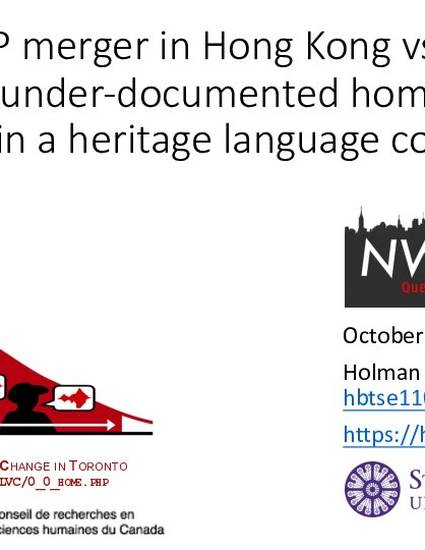
Presentation
AM/P~OM/P merger in Hong Kong vs. Toronto Cantonese: An under-documented homeland sound change in a heritage language context
New Ways of Analyzing Variation (NWAV 51)
(2023)
Abstract
Hong Kong Cantonese has been described as having developed a dissimilatory merger in which /o/ becomes /ɐ/ in pre-labial contexts (/m/ and /p/). The /ɐ/ vs. /o/ distinction (henceforth AM/P vs. OM/P) is illustrated in the following minimal pair (with 35 indicating a mid-rising tone):
[kɐm35], ‘embroidered’, 錦
[kom35], ‘thus’, 噉
Acoustically based studies of this change, however, are lacking presumably because, as Bauer & Benedict (1997: 419–420)claim, the contrast disappeared by around the middle of the 20th century. Can this claim be confirmed through an acoustically based apparent time study? Furthermore, if Cantonese speakers born before the 1950s have settled in other cities such as Toronto, Canada, would heritage speakers there also participate in this change?
The current study specifically addresses the following:
Q1) How are AM/P vs. OM/P produced in terms of F1, F2, and F3?
Q2) How do Pillai Scores (Nycz & Hall-Lew 2015)vary based on Year of Birth?
Q2) Are there differences based on City (Toronto vs. Hong Kong) or on Generational Group (Gen1 vs. Gen2)?
The data comes from sociolinguistic interviews from the Heritage Language Variation and Change (HLVC) Corpus (Nagy 2011).The 38 participants analyzed include eight from Hong Kong and 30 from Toronto (including 15 Gen1 and 15 Gen2). Year of Birth ranged from 1922 to 1998. For each recording, vowel formant measurements were collected using a Praat script. All vowels were normalized and scaled to Hertz values using the Nearey technique (Thomas & Kendall 2007) based on a vowel space of 12 monophthongs. Historic vowel class information was based on Eitel (1877).
Mixed effects modeling of all AM/P (n = 889) and OM/P (n = 816) tokens (with Speaker and Word as random effects; Vowel Category as a fixed effect; and midpoint F1, F2, or F3 as the dependent variable) show that OM/P is significantly raised (lower F1, p < 0.001), significantly retracted (lower F2, p < 0.001), and significantly more rounded (lower F3, p < 0.01) than AM/P. Pillai Scores ranged from 0.04 to 0.86 (with 0 indicating most merged and 1 the least merged). While a Pearson correlation test shows lower Pillai Scores with more recent Years of Birth (r(36) = -0.361, p< 0.05), the change appears to be ongoing, contrary to Bauer & Benedict’s (1997) claim. In fact, the highest Pillai Score comes from a Toronto speaker born in 1969. Nevertheless, neither City nor Generational Group, came out as significant in any model.
To conclude, through acoustic analysis of Homeland speakers, this study shows that a change that was previously described as complete is, in fact, still ongoing. This study, thus, contributes to the description of Hong Kong Cantonese vowel variation, which has been under-researched compared to consonantal and tonal variables (cf. Matthews & Yip 2011: 73–76; Fung & Lee 2019). This study also contributes to a growing number of studies addressing the extent to which heritage speakers participate in Homeland sound change (ex: Thepboriruk 2015; Kang & Nagy 2016; Cheng 2019).
Keywords
- sound change,
- Chinese - Yue,
- vowel merger
Disciplines
Publication Date
October 13, 2023
Location
Queens College - CUNY, New York, NY
Citation Information
Holman Tse. "AM/P~OM/P merger in Hong Kong vs. Toronto Cantonese: An under-documented homeland sound change in a heritage language context" New Ways of Analyzing Variation (NWAV 51) (2023) Available at: http://works.bepress.com/holman-tse/21/
Creative Commons License

This work is licensed under a Creative Commons CC_BY-NC International License.
